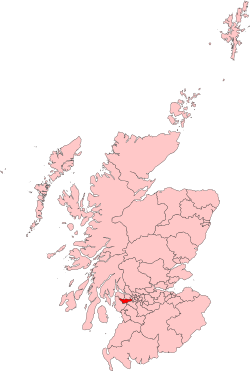Paisley and Renfrewshire South (UK Parliament constituency)
Coordinates: 55°48′50″N 4°29′06″W / 55.814°N 4.485°W
| Paisley and Renfrewshire South | |
|---|---|
|
County constituency for the House of Commons | |
 Boundary of Paisley and Renfrewshire South in Scotland. | |
| Current constituency | |
| Created | 2005 |
| Member of parliament | Mhairi Black (SNP) |
| Created from | Paisley South, Paisley North, and Renfrewshire West |
| Overlaps | |
| European Parliament constituency | Scotland |
Paisley and Renfrewshire South is a constituency of the British House of Commons, located in Renfrewshire, Scotland to the southwest of Glasgow. It elects one Member of Parliament (MP) at least once every five years using the first-past-the-post system of voting.
The seat was formed in 2005, and was traditionally a safe seat for the Labour Party, who previously had a majority of over 16,000 until the SNP gained the seat in the 2015 General Election. Its first MP was Douglas Alexander, who had been the constituency's MP since 2005 (and for the predecessor seat of Paisley South since 1997). Alexander was the Shadow Foreign Secretary, and has previously held cabinet posts such as Transport Secretary and Scottish Secretary (2006–07; joint), and International Development Secretary (2007–10).
Covering the southern portion of the Renfrewshire council area, the east of the constituency takes in the southern half of Paisley, as well as the smaller town of Johnstone and the villages of Kilbarchan and Elderslie. To the south and west of the seat there are rural areas, including the villages of Lochwinnoch and Howwood and natural features such as Castle Semple Loch and the Gleniffer Braes.
Boundaries
This seat was made up off the majority of Paisley South with minor additions from neighbouring constituencies.[1] Population areas in this seat include Glenburn, Saucel and Hunterhill, Johnstone and Kilbarchan.
Members of Parliament
Douglas Alexander represented the constituency from its creation in 2005 to 2015; he had previously represented the former constituency of Paisley South since a 1997 by-election.
| Election | Member | Party | |
|---|---|---|---|
| 2005 | Douglas Alexander | Labour | |
| 2015 | Mhairi Black | SNP | |
Election results
Elections in the 2010s
| Party | Candidate | Votes | % | ± | |
|---|---|---|---|---|---|
| SNP | Mhairi Black | 16,964 | 40.7 | -10.3 | |
| Labour | Alison Dowling | 14,423 | 34.6 | -4.1 | |
| Conservative | Amy Thomson | 8,122 | 19.5 | +11.9 | |
| Liberal Democrat | Eileen McCartin | 1,327 | 3.2 | +1.0 | |
| Independent | Paul Mack | 876 | 2.1 | N/A | |
| Majority | 2,541 | 6.1 | -6.2 | ||
| Turnout | 41,712 | 68.0 | -7.4 | ||
| SNP hold | Swing | -3.1 | |||
| Party | Candidate | Votes | % | ± | |
|---|---|---|---|---|---|
| SNP | Mhairi Black | 23,548 | 50.9 | +32.8 | |
| Labour | Douglas Alexander | 17,864 | 38.6 | –21.0 | |
| Conservative | Fraser Galloway | 3,526 | 7.6 | –2.3 | |
| Liberal Democrat | Eileen McCartin | 1,010 | 2.2 | –7.3 | |
| Scottish Socialist | Sandra Webster | 278 | 0.6 | –0.3 | |
| Majority | 5,684 | 12.3 | |||
| Turnout | 46,226 | 75.4 | +9.1 | ||
| SNP gain from Labour | Swing | +26.9 | |||
| Party | Candidate | Votes | % | ± | |
|---|---|---|---|---|---|
| Labour | Douglas Alexander | 23,842 | 59.6 | +7.0 | |
| SNP | Andrew Doig | 7,228 | 18.1 | +0.5 | |
| Conservative | Gordon McCaskill | 3,979 | 9.9 | +1.5 | |
| Liberal Democrats | Ashay Ghai | 3,812 | 9.5 | –8.1 | |
| Independent | Paul Mack | 513 | 1.3 | ||
| Scottish Socialist | Jimmy Kerr | 375 | 0.9 | –1.1 | |
| Independent | William Hendry | 249 | 0.6 | ||
| Majority | 16,614 | 41.54 | |||
| Turnout | 39,998 | 65.36 | +2.4 | ||
| Labour hold | Swing | +3.27 | |||
Elections in the 2000s
| Party | Candidate | Votes | % | ± | |
|---|---|---|---|---|---|
| Labour | Douglas Alexander | 19,904 | 52.6 | -4.4 | |
| Liberal Democrats | Eileen McCartin | 6,672 | 17.6 | +8.0 | |
| SNP | Andrew Doig | 6,653 | 17.6 | -3.3 | |
| Conservative | Thomas Begg | 3,188 | 8.4 | 0.0 | |
| Scottish Socialist | Iain Hogg | 789 | 2.1 | -0.7 | |
| Pride in Paisley Party | Gordon Matthew | 381 | 1.0 | +1.0 | |
| Independent | Robert Rodgers | 166 | 0.4 | +0.4 | |
| Socialist Labour | Howard Broadbent | 107 | 0.3 | +0.3 | |
| Majority | 13,232 | 34.9 | |||
| Turnout | 37,860 | 62.9 | +6.0 | ||
| Labour hold | Swing | -6.2 | |||
References
- ↑ "Paisley and Renfrewshire South: Aristotle". London: The Guardian. Archived from the original on 18 June 2008. Retrieved 2008-05-28.
- ↑
- ↑
- ↑
- ↑ "Election Data 2015". Electoral Calculus. Archived from the original on 17 October 2015. Retrieved 17 October 2015.
- ↑ "Election Data 2010". Electoral Calculus. Archived from the original on 26 July 2013. Retrieved 17 October 2015.
- ↑ "Election Data 2005". Electoral Calculus. Archived from the original on 15 October 2011. Retrieved 18 October 2015.